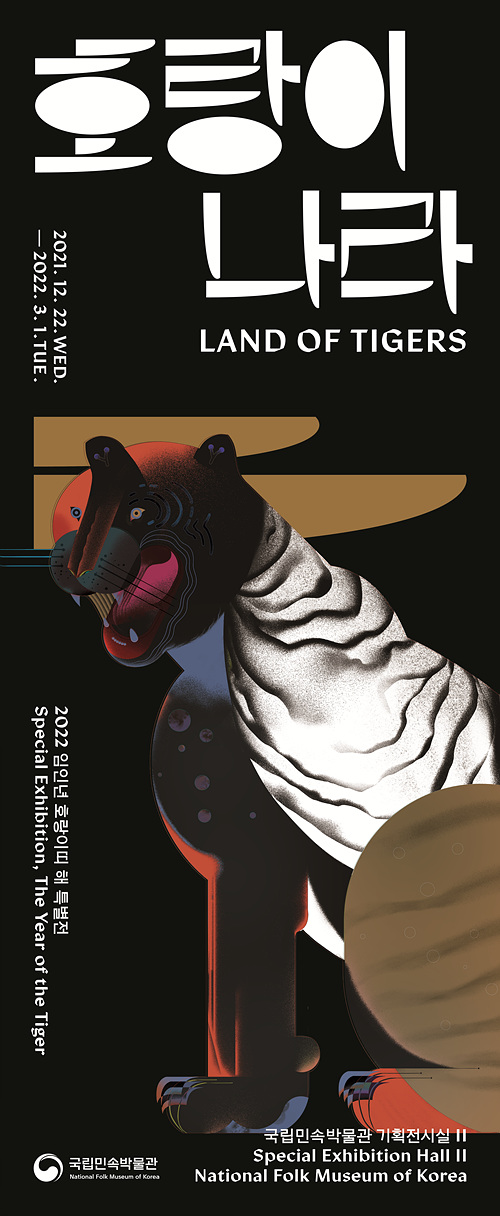Exhibitions
| Title | Land of Tigers |
|---|---|
| Period | 2021.12.22~2022.3.1 |
| Venue | Special Exhibition Ⅱ |
|
Land of tigersCelebrating the year of imin (壬寅年, the 39th year of the sexagenary cycle), which is the year of the tiger, the National Folk Museum of Korea holds a special exhibition exploring the symbolism and cultural images of the tiger.Tigers are apex predators in the ecosystem. That is why tigers have symbolized bravery since ancient times and were deified as mountain gods that guard our villages. In folk tales, they sometimes appear as personified characters, performing filial duty or showing gratitude. The tiger has been in our lives in many ways and it is one of the representative animals of Korean culture. This special exhibition, Land of Tigers , presents various cultural symbols and meanings of the tiger. We hope you get lots of energy from the tiger and wish peace in you and your family throughout the year of the tiger.  Ecology and Behavior of TigersTigers are in the cat family and have black stripes on a yellowish brown fur all around their bodies. Their lifespan is about 15 years to 20 years. Female tigers are pregnant for about 100 to 110 days, and they give birth to 2~4 cubs at a time.This carnivorous animal runs fast and can jump very high. The tiger also has strong canine teeth and forepaws which makes it very easy to hunt other animals. Because tigers are nocturnal, they like dusk. They are wild animals usually living in the mountains. In the past, there used to be a lot of tigers living in Korea since it has thousands of mountains. However, the tiger is now an endangered species. The Twelve Zodiac Animals and the TigerThe tiger is the third of the 12 Zodiac animals, appearing in the order of byeongin, muin, gyeongin, imin, gabin, and so on in the sexagenary cycle. In terms of directions, it is referred to by the term inbang, which means east-northeast. In terms of time, inwol and insi represent the first lunar month and 3 to 5 AM respectively.Korean people tend to analyze their disposition or predict their marital harmony based on the zodiac animal that corresponds to the year they were born. They also foretell their fortune of a year or the destiny of their entire life in the same way. People who were born in the year of the tiger are believed to be brave, adventurous and honest, well-matched with those born in the years of the horse and the dog while incompatible with those born in the years of the cow and the monkey. Symbols and Cultural Images of TigersThe tiger appears in folk beliefs and oral literature in various ways. It sits as a mountain god and guards the village, and is drawn on paintings or talismans to defeat misfortune. In funeral rites the tiger is thought to guide the dead to heaven, making connection between this life and afterlife. Guarding the grave is also believed to be its duty.In folk tales and oral traditions, tigers are considered as mystical creatures that sometimes practice filial piety or return someone else’s favor, while other times they get in trouble with their own foolishness. At all times, they are there to give us life lessons. Contemporary Adaptation of the TigerFrom ancient times tigers were one of the symbols of Korea and they still are.‘Hodori’ of 1988 Seoul Olympics and ‘Soohorang’ of 2018 Pyeongchang Olympics were mascots using tiger characters, representing Korea in the international sport events. The tiger is also in the emblem of our national soccer team. Moreover, military units and schools also choose to use tigers as their symbol, hoping their soldiers or students to be brave and adventurous like them. |
|
| Date | 2021-12-22 |
| 이전글 | Our Lives Beyond Epidemics |
|---|---|
| 다음글 | Sacred Tiger |


